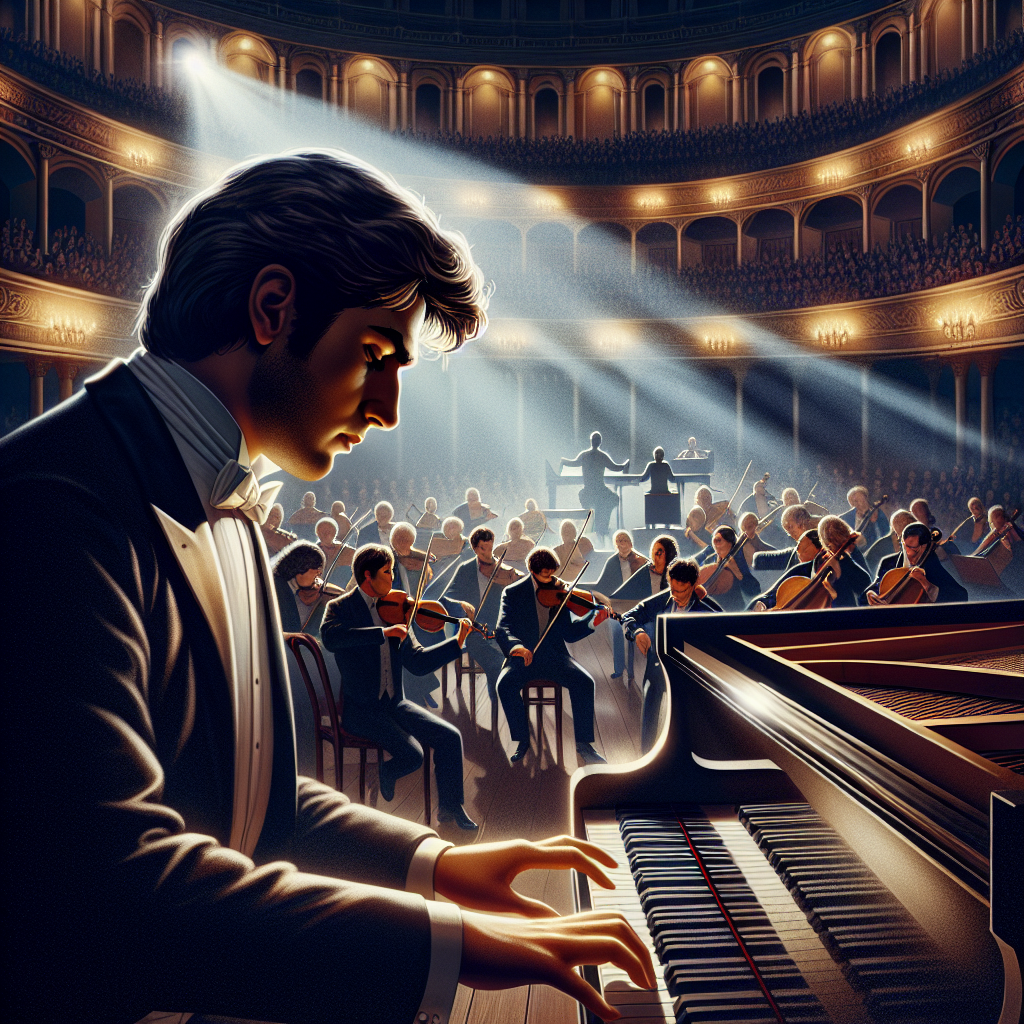
Performer’s Insight – Interpreting Beethoven’s Concertos
Ludwig van Beethoven stands as a towering figure in the history of Western classical music. His life and works have influenced countless composers and musicians, serving as a perennial source of inspiration and challenge. This article delves into the world of Beethoven’s concertos, providing a performer’s insight into interpreting these complex works. As performers develop their craft, gaining a deeper understanding of Beethoven’s intentions and stylistic nuances can significantly enhance their interpretations, allowing them to deliver performances that are both faithful to the scores and emotionally resonant with audiences.
Born in 1770 in Bonn, Germany, Beethoven began his musical education under the strict guidance of his father and later studied with renowned teachers such as Christian Gottlob Neefe. His early years were marked by prodigious talent and a relentless pursuit of mastery. By his teenage years, Beethoven was already a sought-after performer and composer, setting the stage for his later monumental contributions to music. Despite facing personal struggles, including his eventual deafness, Beethoven continued to compose until his death in 1827.
Among Beethoven’s extensive oeuvre, his concertos hold a special place. These works, written for solo instruments accompanied by an orchestra, showcase the interplay between individual virtuosity and collective musicality. Beethoven composed five piano concertos, a violin concerto, and a triple concerto for violin, cello, and piano. Each of these compositions reveals different facets of his genius, from the dramatic and heroic to the lyrical and tender.
Understanding the historical context and Beethoven’s compositional style is crucial for any performer aiming to bring his concertos to life. This journey into the world of Beethoven’s concertos will offer insights into his creative processes, performance practices, and the interpretative choices that can transform a mere execution of notes into a profound musical experience. Let’s embark on this exploration of how to engage with and interpret these timeless masterpieces effectively.
Beethoven’s Piano Concerto No. 1
Beethoven’s Piano Concerto No. 1 in C Major, Op. 15, represents a significant leap in his compositional style from his earlier works. Written between 1796 and 1797, it was created during a period when Beethoven was beginning to establish himself in Vienna. As a performer, this concerto offers a compelling mix of classical structures with early signs of Beethoven’s innovative spirit.
Performers must pay close attention to the dialogical nature of this concerto. The interplay between the piano and the orchestra embodies a conversation, with themes introduced by one and responded to or developed by the other. The opening Allegro con brio sets a vibrant and majestic tone, where maintaining clarity and precision in articulation is essential for both the soloist and the orchestra.
The Largo, the second movement, demands a more introspective approach. Here, Beethoven’s lyrical writing allows the performer to explore a wide palette of emotional expressions, from serene calm to deep melancholy. Balancing the simple beauty of the melody with the underlying harmonic complexities enables the interpreter to convey the depth of this movement effectively.
The final Rondo draws from the classical tradition of Haydn and Mozart but injects Beethoven’s own vigorous character. Performers should aim to capture the playful and spirited nature of this movement, ensuring that the thematic material is presented with vivacity and a sense of joy. Understanding the historical context in which Beethoven composed this piece, such as his successes in Vienna and his development as a performer, aids in delivering a nuanced and historically informed performance.
Beethoven’s Violin Concerto in D Major
The Violin Concerto in D Major, Op. 61, is one of Beethoven’s most revered works, revered for its lyrical beauty and structural mastery. Composed in 1806, it embodies Beethoven’s mature style, characterized by expansive melodic lines and innovative orchestral textures. This concerto presents a formidable challenge for soloists, requiring technical proficiency and deep interpretative insight.
The first movement, Allegro ma non troppo, opens with a long orchestral introduction, setting up the themes that the violin subsequently takes up and elaborates. The soloist must navigate between the grandeur of the orchestral statements and the more intimate passages, making use of dynamic contrasts and varied articulations to bring the narrative to life.
The second movement, Larghetto, offers a serene, almost meditative counterbalance to the first. It features a series of variations, with the soloist’s role being both reflective and embellishing. Capturing the ethereal quality of this movement requires a nuanced approach to phrasing and tone production.
In the final movement, Rondo, the soloist faces virtuosic challenges while maintaining a dance-like, joyful character. The recurring rondo theme demands clarity and brightness, with each return inviting the performer to bring a fresh and lively interpretation. The cadenza, often a showcase for the soloist’s technical prowess and creativity, should be well-prepared and delivered with confidence and flair.
Understanding Beethoven’s approach to the violin concerto, and how he expanded the technical and expressive range of the instrument, can enhance the performer’s connection to the piece. Historical insights into the concerto’s first performance by Franz Clement and subsequent revisions can offer valuable perspectives on interpretation.

Beethoven’s Third Piano Concerto
The Third Piano Concerto in C Minor, Op. 37, marks a pivotal moment in Beethoven’s development as a composer. Composed in 1800, it straddles the Classical and Romantic eras, showcasing a dramatic intensity that hints at Beethoven’s later, more tumultuous works. For performers, this concerto presents an opportunity to explore Beethoven’s evolving musical language.
The first movement, Allegro con brio, starts with a brooding orchestral introduction that sets a dramatic stage for the soloist’s entry. The C minor tonality creates a somber mood, which the performer must convey through powerful dynamic contrasts and emphatic phrasing. When the piano finally enters, it is with a sense of urgency and intensity that demands both technical agility and emotional depth.
The second movement, Largo, in E Major, offers a stark contrast with its serene and introspective character. Here, the performer can delve into the lyrical and expressive aspects of Beethoven’s writing. The lush harmonies and flowing melodic lines require a delicate touch and a keen sense of pacing to maintain the movement’s contemplative atmosphere.
The final movement, Rondo – Allegro, returns to the energetic and assertive style of the first. The playful rondo theme requires crisp articulation and rhythmic precision from the soloist. Each appearance of the theme should be treated with a fresh perspective, adding variability and excitement to the performance. The cadenza, a highlight of this movement, provides a space for the pianist to exhibit technical brilliance and interpretive insight.
A deep understanding of Beethoven’s musical context and his personal struggles, particularly his increasing deafness at the time, can inform the performer’s interpretation. Emphasizing the dramatic contrasts and the emotional depth of this concerto can bring forth the powerful essence of Beethoven’s vision.
Performing Beethoven’s Concertos Today
Interpretation of Beethoven’s concertos in the modern era involves balancing historical performance practices with contemporary sensibilities. Today’s performers have access to a wealth of resources, including historical manuscripts, recordings of renowned pianists, and academic research on Beethoven’s music. Incorporating these elements can significantly enrich a performance.
One important aspect is understanding the instruments of Beethoven’s time versus modern instruments. Beethoven composed his concertos with the fortepiano in mind, an instrument with a different touch and tonal quality than today’s grand piano. While modern pianos offer a broader dynamic range and sustain, performers must adapt their techniques to approximate the articulation and clarity of the fortepiano.
Historical context further enhances interpretation. Knowledge of the social, political, and personal circumstances surrounding Beethoven’s compositions can provide deeper insight into the emotional landscape of his concertos. For example, his struggle with hearing loss and his desire to express profound human experiences through music can inspire a more heartfelt and authentic performance.
Incorporating interpretative insights from historical performers and contemporary experts can also be beneficial. Studying recordings of legendary interpreters like Wilhelm Kempff, Arthur Schnabel, and Anne-Sophie Mutter, among others, can offer perspectives on phrasing, tempo choices, and emotional delivery. Engaging with scholarly articles and attending masterclasses can provide additional interpretive strategies and technical advice.
Ultimately, performing Beethoven’s concertos is a journey that blends respect for historical authenticity with personal artistic vision. By combining technical mastery, historical understanding, and emotional connection, performers can create interpretations that honor Beethoven’s genius while speaking directly to the hearts of modern audiences.
Conclusion
Interpreting Beethoven’s concertos is a profound artistic endeavor that demands technical proficiency, historical knowledge, and emotional insight. Through a careful study of his concertos, performers can uncover the layers of complexity and beauty that define Beethoven’s music. Each concerto offers a unique window into his creative genius, from the classical elegance of the Piano Concerto No. 1 to the dramatic depth of the Third Piano Concerto and the lyrical splendor of the Violin Concerto.
Performers must balance historical performance practices with their own artistic interpretations, drawing from a rich tapestry of historical context, scholarly research, and the legacy of past performers. This comprehensive approach enables them to deliver performances that are both true to Beethoven’s intentions and resonant with contemporary audiences.
Engaging with Beethoven’s concertos on this deeper level not only enhances performance skills but also fosters a more intimate connection with the music. By immersing themselves in the historical and emotional landscape of these works, performers can convey the profound human experiences that Beethoven sought to express. The journey of interpreting Beethoven’s concertos is one of continual learning and discovery, offering endless opportunities for artistic growth and expression.
As we continue to celebrate Beethoven’s legacy, his concertos remain a testament to his enduring influence in the world of classical music. These works challenge performers to push the boundaries of their abilities, inviting them to explore the vast possibilities of expression and interpretation. By delving into the life and works of Ludwig van Beethoven, musicians and audiences alike can continue to find inspiration and insight, ensuring that his music remains a vital and vibrant part of our cultural heritage.